On 17th September 2020, the “Nanshan 138: Zhejiang youth promotion project of contemporary art (2020)” hosted it’s third solo exhibition: “Cao Ou: The entropy disappear at absolute zero” in the Zhejiang art museum. Cao ou attended the museum and provided a live review of the exhibition, which opened a new model of online and offline interaction, which received lots of viewers with very positive feedback. The exhibition continues until 18th October 2020.

The origin of the “Coexistence” series comes from Cao Ou’s two years of work experience within natural museums. At that time, he visited many natural museums and came into contact with animal, plant fossils and bones, and viewed many animal and plant specimens and drawings. “Coexistence” is literally understood as living together in nature, but the inspiration for Cao Ou is more about the cycle of life and death, as well as the way of getting along with each species. It is a metaphor for there are many law of life cycle in nature. Human beings live in nature. So we are also participants of the law. The “Coexistence” series depicts animals and insects. Cao Ou arranges these animals like chess pieces and expresses his thoughts on the laws of nature from the perspective of the viewer.
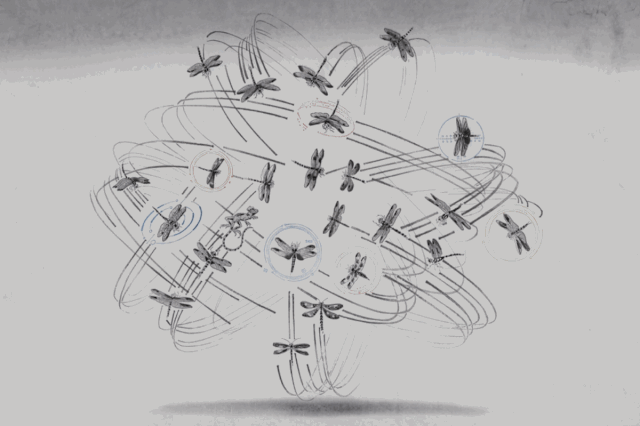
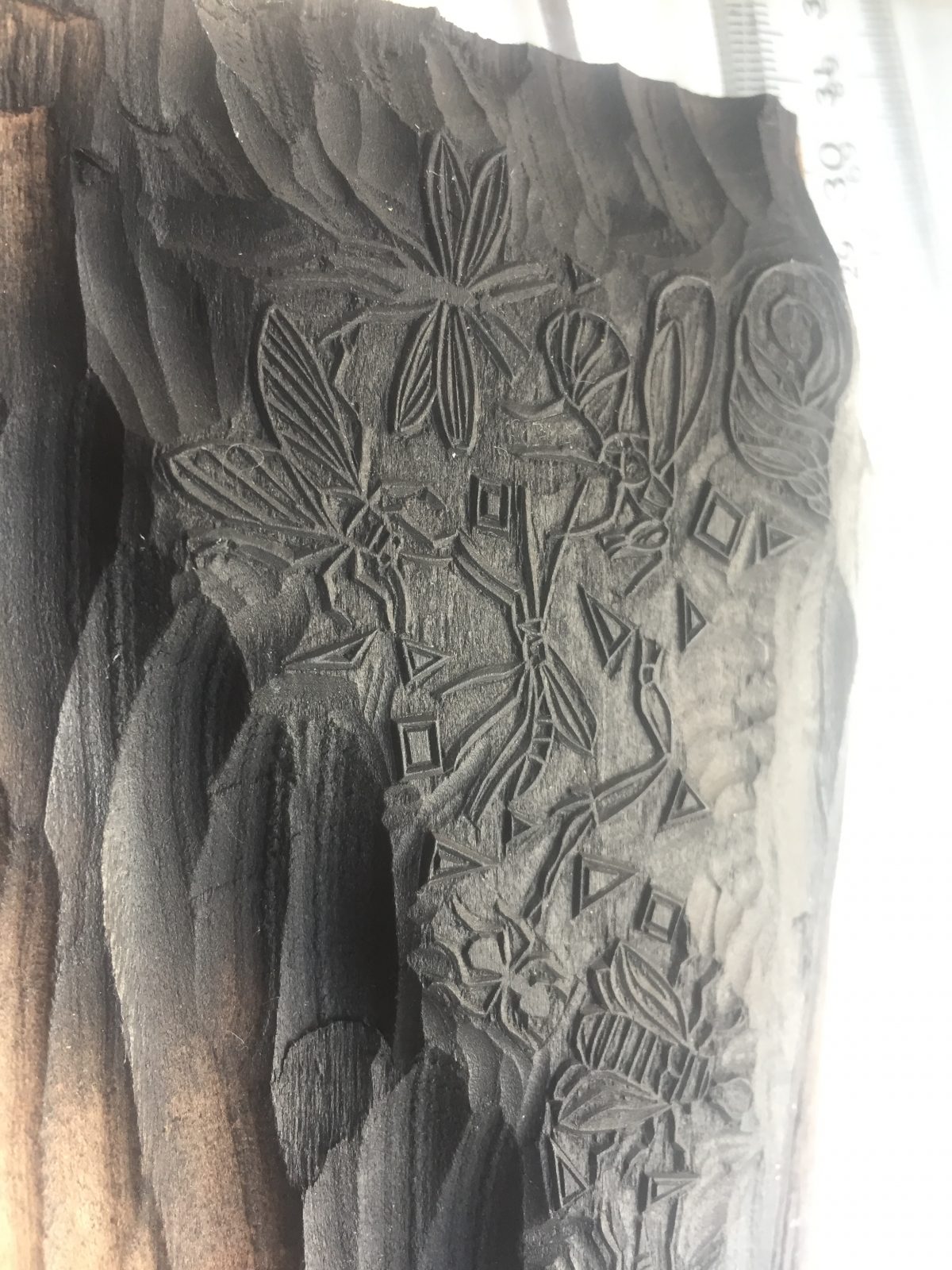
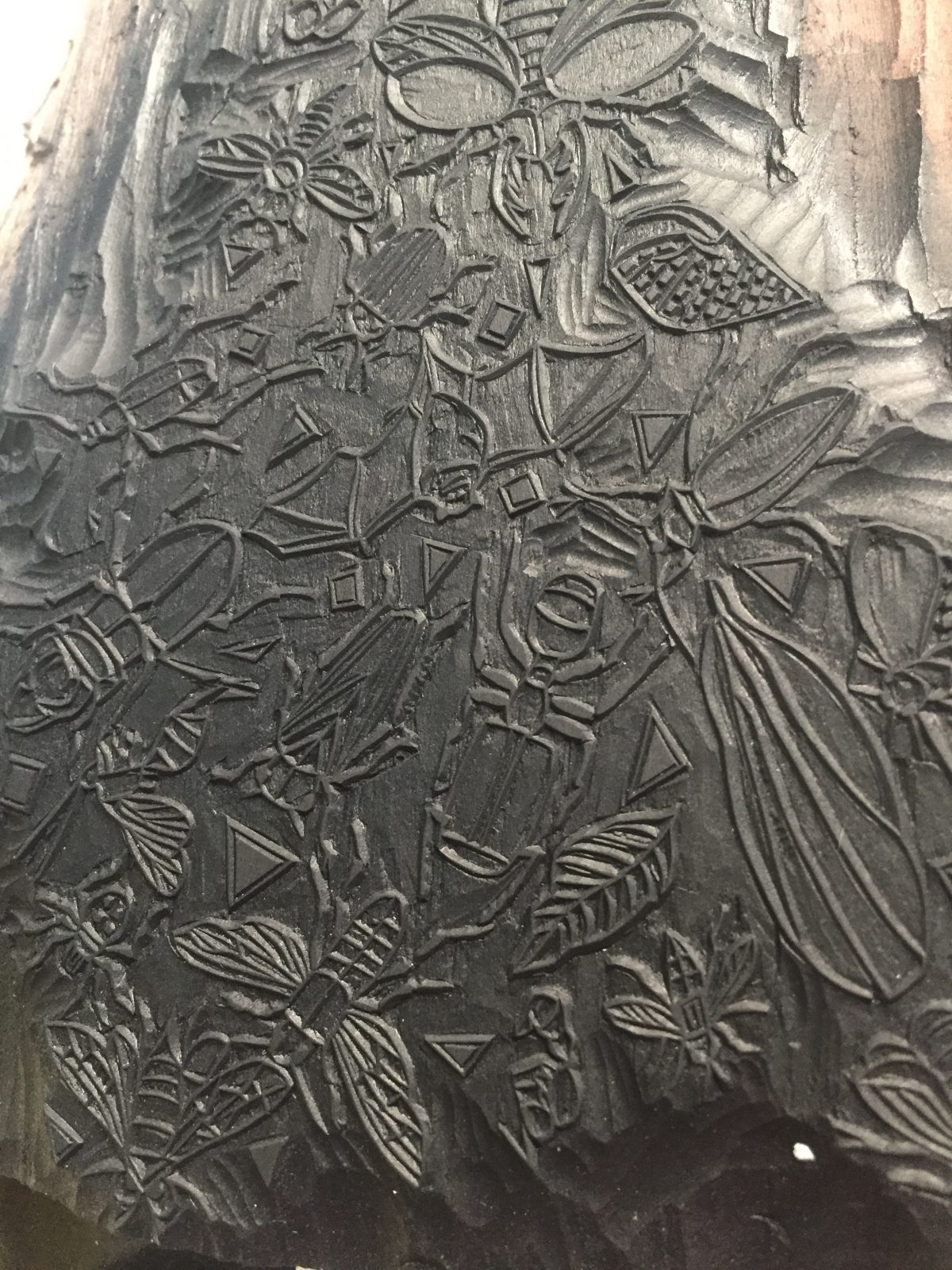
Things that seem to be out of order in nature are carried out in an orderly manner and follow the law of life cycle. The primary law of nature is from disorder to order and then back to disorder. For example, the solar system has evolved from disorderly chaos to orderly, and will fall into disorder in the future; life will evolve from chaotic inorganic matter to a colourful life form, and it will also die out and turn into dust in the future.
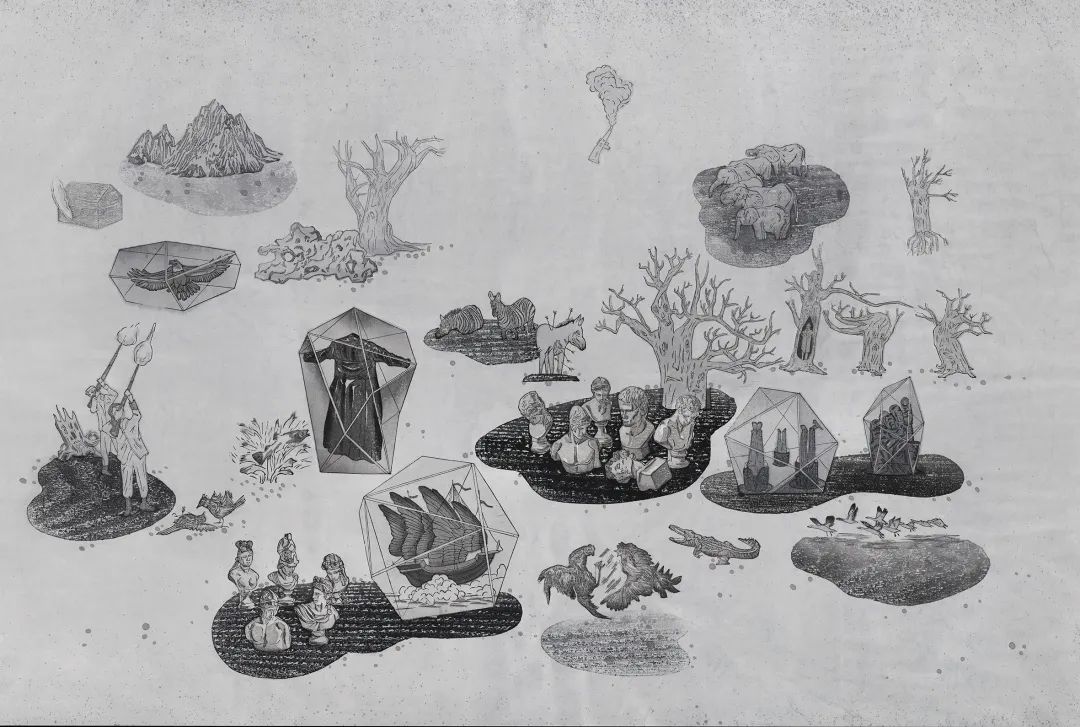
In this print, Cao Ou created a wasteland where a person coexists with animals and plants. They seem to be unrelated, but they all exist disorderly on the wasteland. The subconscious self-protection becomes their fortress, forming a disorderly absurd image.
“Physics Diary Series” is Cao Ou’s first attempt to intervene in the “archaeological” performance of anthropology from an artistic perspective. A random contingency is used to contrast the scientific rigour of professional archaeologists, and the absurd words formed by these contingencies can dispel the public’s perception of familiar attitudes in museums.

The news continually reports COVID-19 daily on the TV and I think about it every day too. The focus is on numbers, the number of deaths. After a while my mind became numb and I didn’t feel nervous anymore. I played games for a few days, my eyes became sore, so I decided to find some books to read.
After reflecting on my works, I decided that I needed to systematically read some books on Chinese contemporary art, performance art, installation art and so on. I think if I want to make a breakthrough in my work, then I need to think outside of my box. The first book I read was Wu Hong’s “The Best Use of Everything, No Waste”.
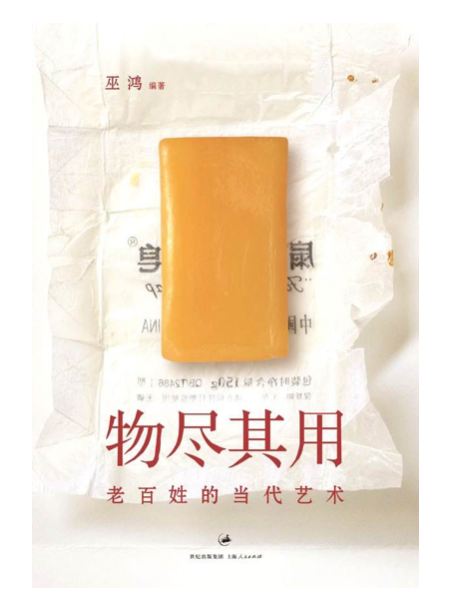
The book is about Song Tong’s installation titled “The Best Use of Everything – No Waste”. The artist’s father died unexpectedly which his mother found very hard to accept. She started to keep every used item in the house, no one was allowed to throw anything away. More and more things accumulate in the house, so Song Dong persuaded his mother to move them to a museum. Making the most of everything, no waste, was the philosophy of his mother’s generation. Through this exhibition, Song Dong’s mother starts to tell the story of each object to the audience, gradually his mother’s sadness subsides and smiles return to her face.
This book makes me believe there is life in each object, that’s why Song Dong’s mother didn’t just throw them away after use. Instead, she puts them in the museum. Such as a lighter, a mineral water bottle, a piece of soap and a piece of cloth. These ordinary and worthless objects are finally shown to people in the most dignified way in the museum. After being consumed by people, they survive in the most dignified way. Each of them has a life and a story. Many of the objects are decades old, and they are also witnesses of historical change. The exhibition was a healing experience for Song’s mother, who probably didn’t understand contemporary art. But, the show is more effective than any medical treatment for her, and that’s probably the value of art. It really can be therapeutic.
Our whole family drove back to my hometown in Shandong just five days before Chinese New Year’s Eve in 2020. We saw the news about Wuhan’s pneumonia on our phones. The report said it was not serious. I didn’t even watch the news and only heard a few words about it from the family.
My studio
We stopped a few times in the services on the highway during our journey. The services were busy, and nobody was wearing a mask. It surprised me how many people went back home much earlier, and there were not so many people around this time as in previous years. It usually gets crowded 2 days before the New Year. Normally this is a 12 hour journey, but it took us over 16 hours because of the traffic. It was ok for us, but my poor cat suffered as it couldn’t go to the toilet for the whole duration.
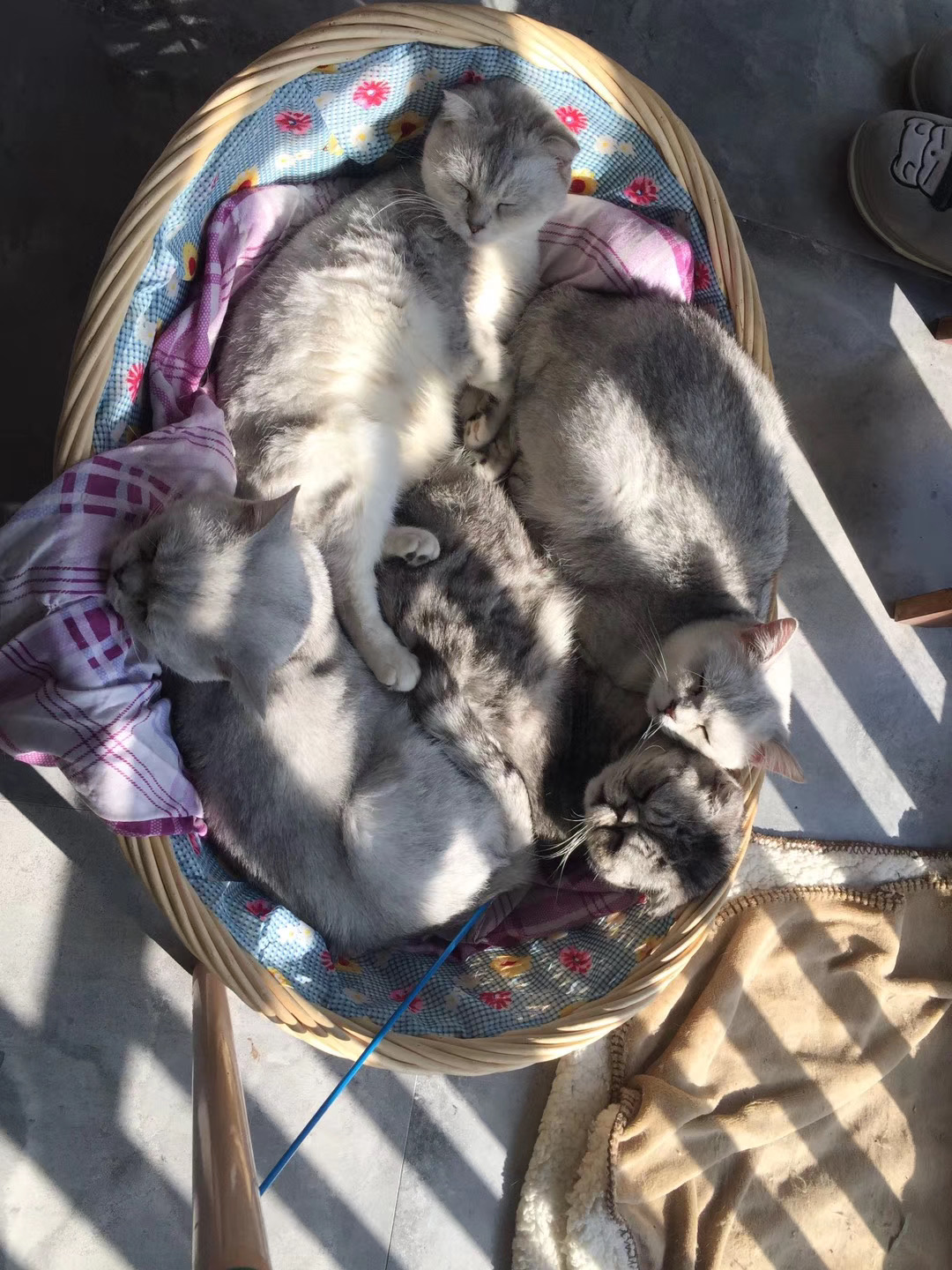
My lovely cats
Since I hadn’t been home for two years, I went out for a drink with friends most nights before my departure. After we arrived at my parents’ home, Wuhan’s epidemic was getting worse. I watched the news and paid more attention to the situation.
I have a friend in Wuhan. So I chatted with him and asked him how it was there. He was shopping at the supermarket and was wearing a mask by then. There were many people in the supermarket. He said that the news of the epidemic was bad. However, people remained very relaxed. Life continued as normal,the epidemic seemed to be no big deal.
My work used for this book’s cover.
At noon on New Year’s Day, our family was still eating out at a restaurant. On the next day, my city suddenly issued an emergency notice that all restaurants, shops, leisure centres, and other public places should close at once – this was mandatory. We lined up outside a shop and started buying masks. The medicine in the pharmacy was almost wiped out. Everyone bought hundreds of RMB worth of medicine to prepare for a long time staying at home. A mask was a few cents, so I bought a pack. The next day we remained at home. The first thing in the morning is to watch the news. We found the number of affected people had increased several times from the previous day. Two days later, all the residential districts were closed. Now you must wear a mask and measure your temperature when entering the residential district. At the beginning of New Year, from the first day to the fifteenth, is a time for families and friends to come together. However, everything had to be cancelled.
Words by Aimin Liu, founder of ArtChina UK
We’re thrilled to share the great news that in November, one of the young Chinese artists in our collection, Cao Ou’s newest print series continuing his ‘Theatre’ Landscape theme was shortlisted for ‘The Fourth Muban Educational Trust Woodblock Printmaking Award’.
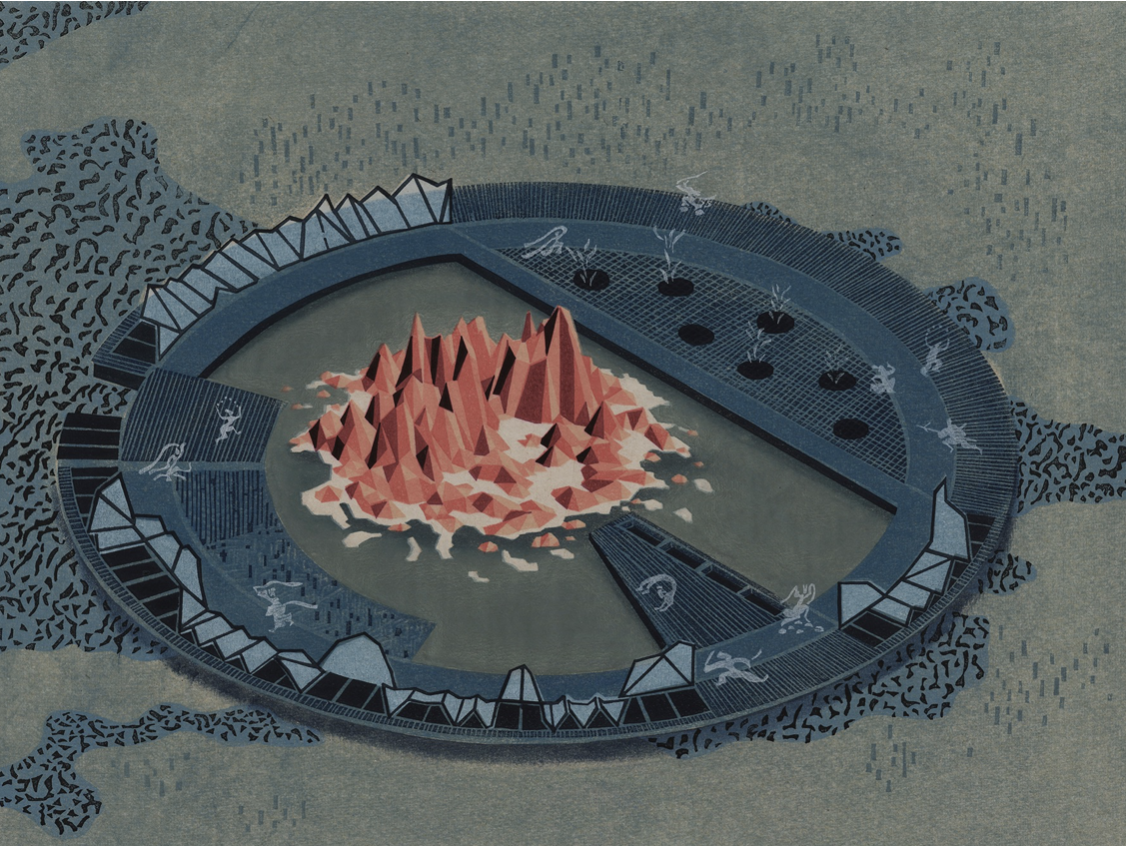 Image: ‘Theatre’ Landscape – Feature Mountain, Water-Based Woodcut, 45x60cm, 2019
Image: ‘Theatre’ Landscape – Feature Mountain, Water-Based Woodcut, 45x60cm, 2019
Back in June, when I was visiting Cao’s studio in Hangzhou, he was telling me about his ideas for these new works, and he showed me some of his drafted drawings too. Now at end of this year, he not only finished his creations, but also won the award – what an achievement for him, especially while at the same time he has been busy creating, he has also been looking after his young baby.
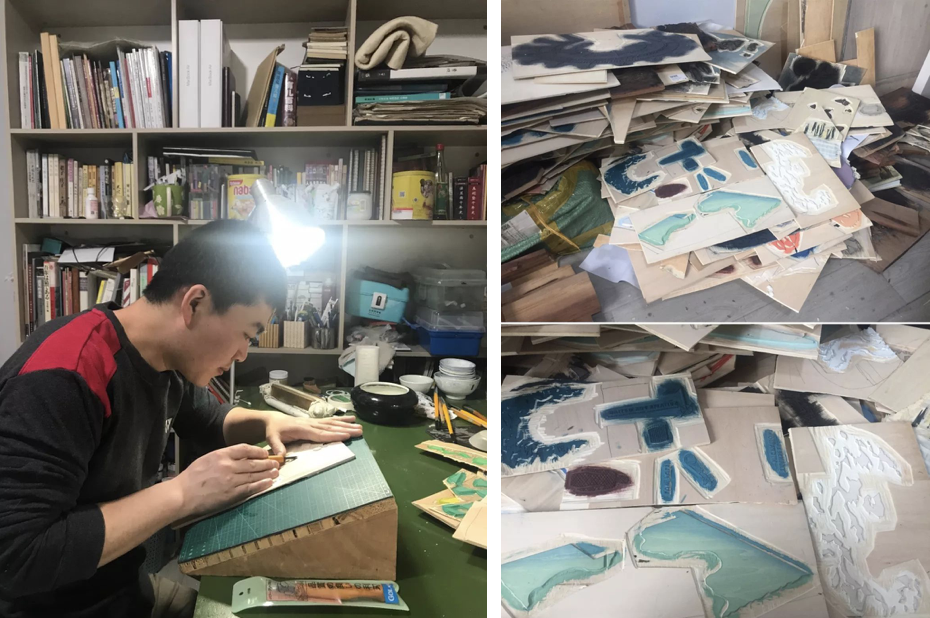
 Image: ‘Theatre’ Landscape – Machine Made, Water-Based Woodcut, 45x60cm, 2019
Image: ‘Theatre’ Landscape – Machine Made, Water-Based Woodcut, 45x60cm, 2019
In the ‘Theatre ‘ Landscape series, the landscapes come from his imagination. They are his own abstract interpretations different from the classical Chinese landscape paintings; the visuals of landscapes in these works have a strong distinction from work created in the old days. This imaginative series, revealed to us by Cao, was created by using difference image coding, media, and methods.
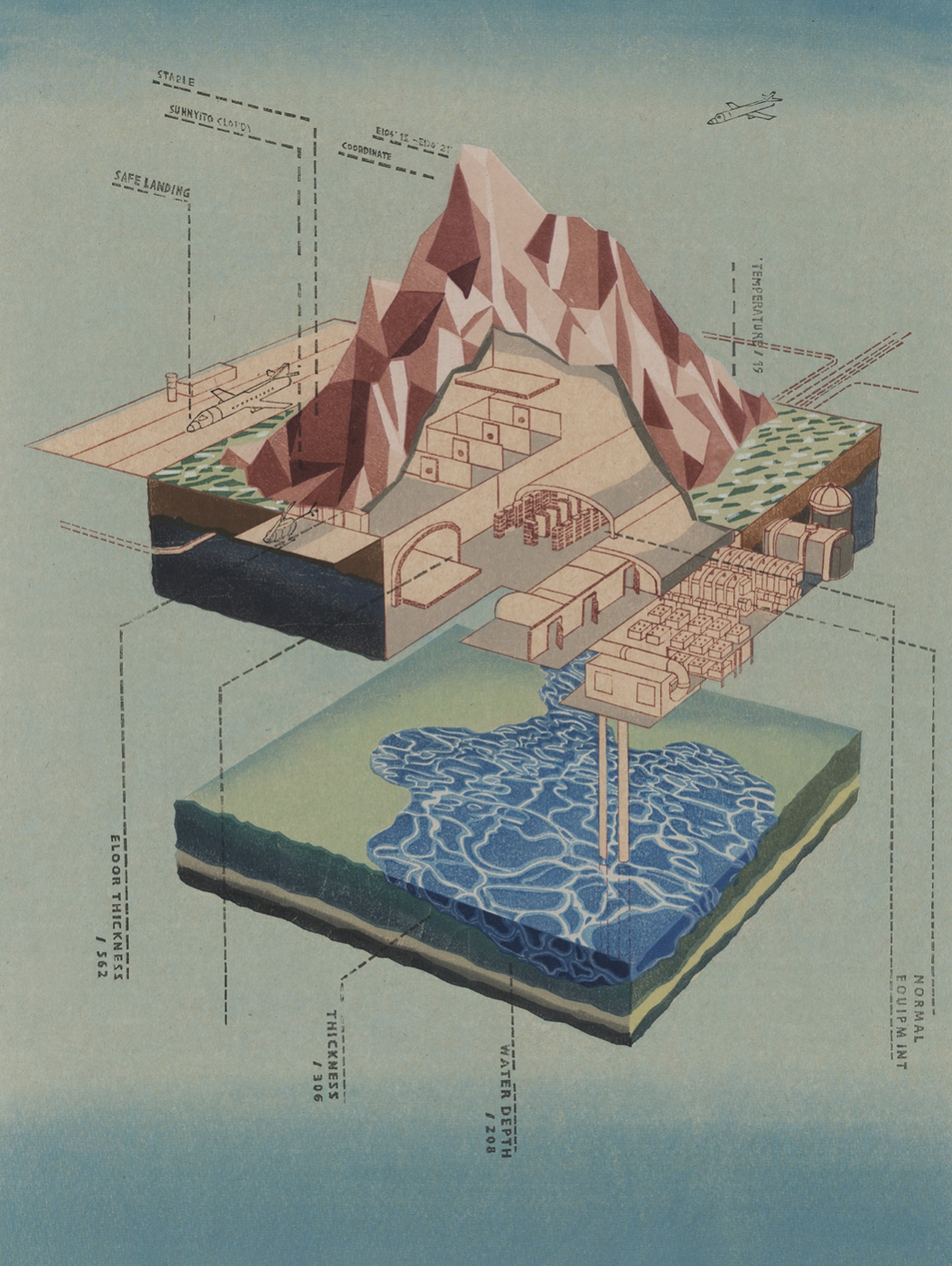 Image: ‘Theatre’ Landscape – Analyse, Water-Based Woodcut, 45x60cm, 2019
Image: ‘Theatre’ Landscape – Analyse, Water-Based Woodcut, 45x60cm, 2019
Landscapes in Cao’s prints no longer represent nature in our reality; instead, viewers will discover big changes to our environment that have come from importing western culture, technology’s revolution, new techniques, pioneer philosophy, and the fast developments of the cities in China.
 Image: ‘Theatre’ Landscape – Unfolded Structure, Water-Based Woodcut, 45x60cm, 2019
Image: ‘Theatre’ Landscape – Unfolded Structure, Water-Based Woodcut, 45x60cm, 2019
 Image: ‘Theatre’ Landscape – Waterfall Mountain , Water-Based Woodcut, 45x60cm, 2019
Image: ‘Theatre’ Landscape – Waterfall Mountain , Water-Based Woodcut, 45x60cm, 2019
This series has 18 prints. Cao had chosen five of them to participate the competition.
He used the traditional printing technique, called ‘Do Ban’ which dates back to the 17th century. Each of his prints used more than 10 pear wood blocks, and were hand-printed on Pi Paper (a type of bark paper) with water-based ink. This series continues and expands on the style of ‘flat design’ from his previous series which was titled ‘Construction Landscape’. This time, he also added narrative into each print, so that every print not only purely represents the landscape, but you also can also read a story or find more interesting details added into each of them. There are words, figures, animals, houses, and other variety of objects inserted in order to convey to the audience the dynamic relationships between our living environment today and us as human beings. They are meant to evoke further questions ‘How can we protect our blue planet for ourselves right now and for our future generations?’
Cao Ou talks about his newest work,”Tin Toy Series” as the Woolwich Contemporary Print Fair begins today.
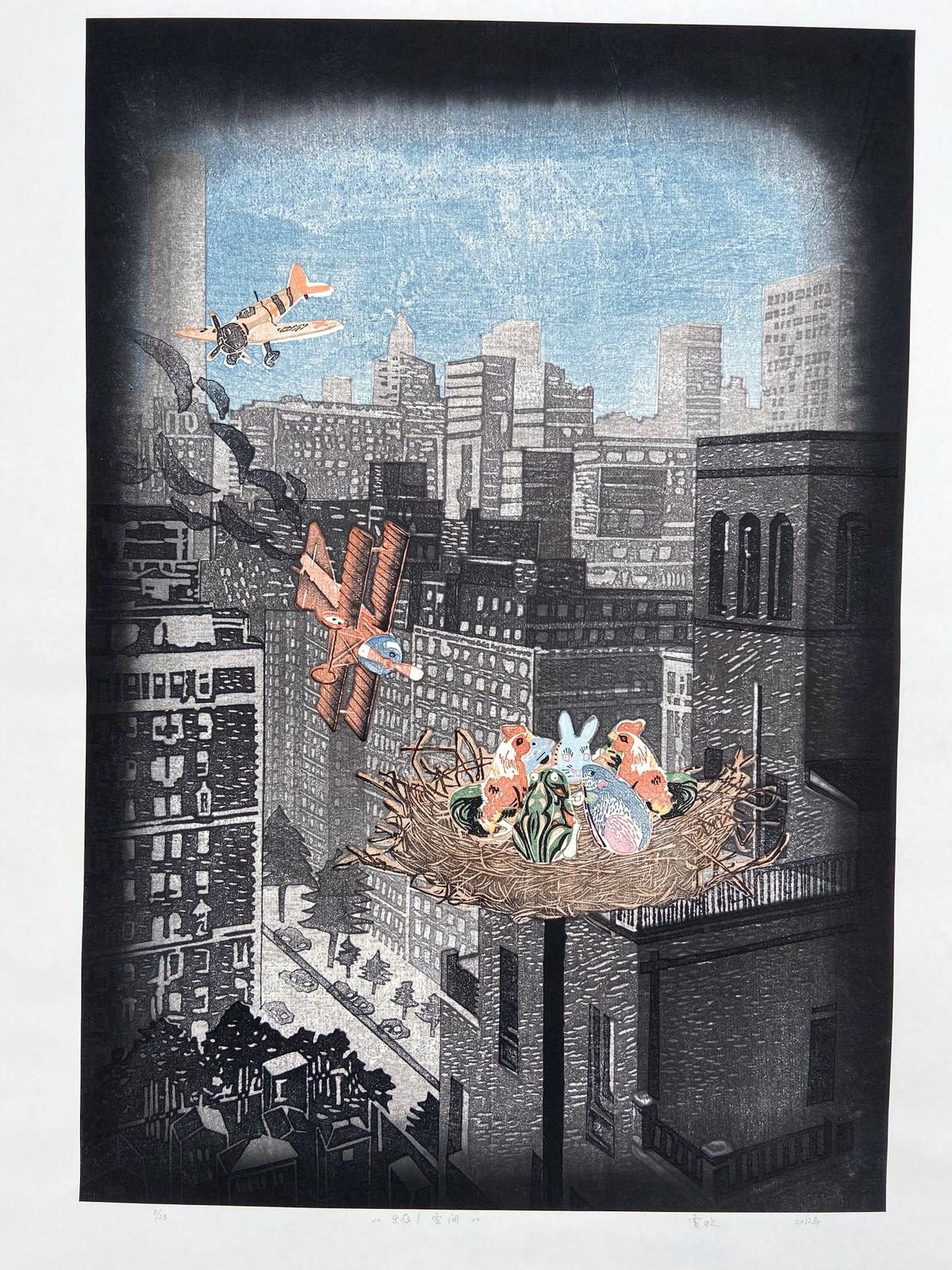 <SURVIVAL! SPACE!>
<SURVIVAL! SPACE!>
This painting addresses the stress of living. The background of the painting is a congested modern metropolis and, without a foothold for a nest, birds can only dully stare at each other in the nest which is supported by an extremely thin pillar. The nest is isolated and in danger, a damaged aircraft is falling towards it, which implies that accidents are unavoidable even though living in an isolated nest. The scene is surrounded by black colour, which is to increase the oppression of the picture, and to create a sense of tragedy.
 <FORWARD? BACKWARD?>
<FORWARD? BACKWARD?>
This painting expresses a confusion I had about my future path and didn’t know where to go when I just graduated. In the picture, it’s a tunnel at the end of the path (because the tunnel is dark, it can be interpreted as the road leading to darkness, but only after passing through the tunnel will the light come). On the road, there are two signposts for passage and no passage, the roadblock is also half open. All those details imply that the choice is yours, you have to make decision on your own, that was the mindset for new graduate.
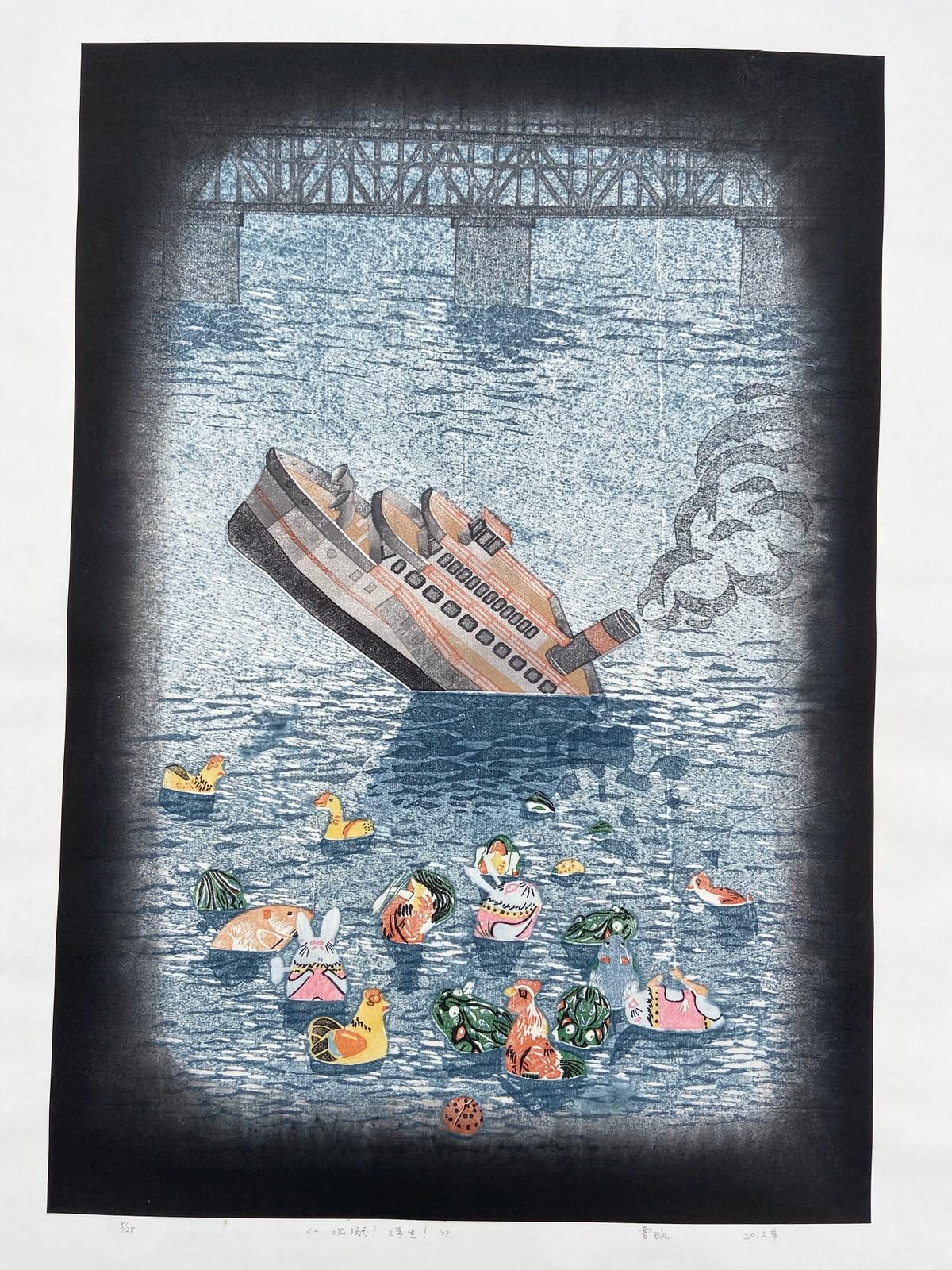 <SINKING! FLOATING!>
<SINKING! FLOATING!>
I was living near a bridge over the Qian Tang River. In the picture, the bridge in the background has a delineated base. Due to the situation of the spring tide, the Qian Tang River drowns people who come to watch it each year, and those victims mostly are tourists. Thereby, I addresses the event as a beautiful thing, while unexpected accidents still happen while people are enjoying it which is not something that can be controlled by human beings.
 <LEAP FORWARD! COLLAPSE!>
<LEAP FORWARD! COLLAPSE!>
“LEAP FORWARD”, the title of the work, was implanted with a meaning. In the 1050s in China, there was a historical event of “the great leap forward” which was to develop the social economy at all costs. I was inspired by the fact that I’m living in today’s era of rapid economic development, (certainly conditions of development have improved), yet I want to reflect that there are still some trade-offs. There’s an old saying in China: Man struggles upwards; water flows downwards. In the picture, I depicted an arched roof as a background. It’s a perspective of looking up, and the frogs (referring to the people) are struggling to reach higher. Some of them are already fragmented in their bodies, thus incurring the phenomenon of collapse, signifying overloaded behaviour such as people working overtime, etc.
Contact us for available prints.
ArtChina founder Aimin is travelling through China this week, visiting art universities and studios, checking in with our artists and meeting some new talents. One of her first stops was China Academy of Arts in Hangzhou where she spent some time at Zi Zhu Studio in the printmaking department.
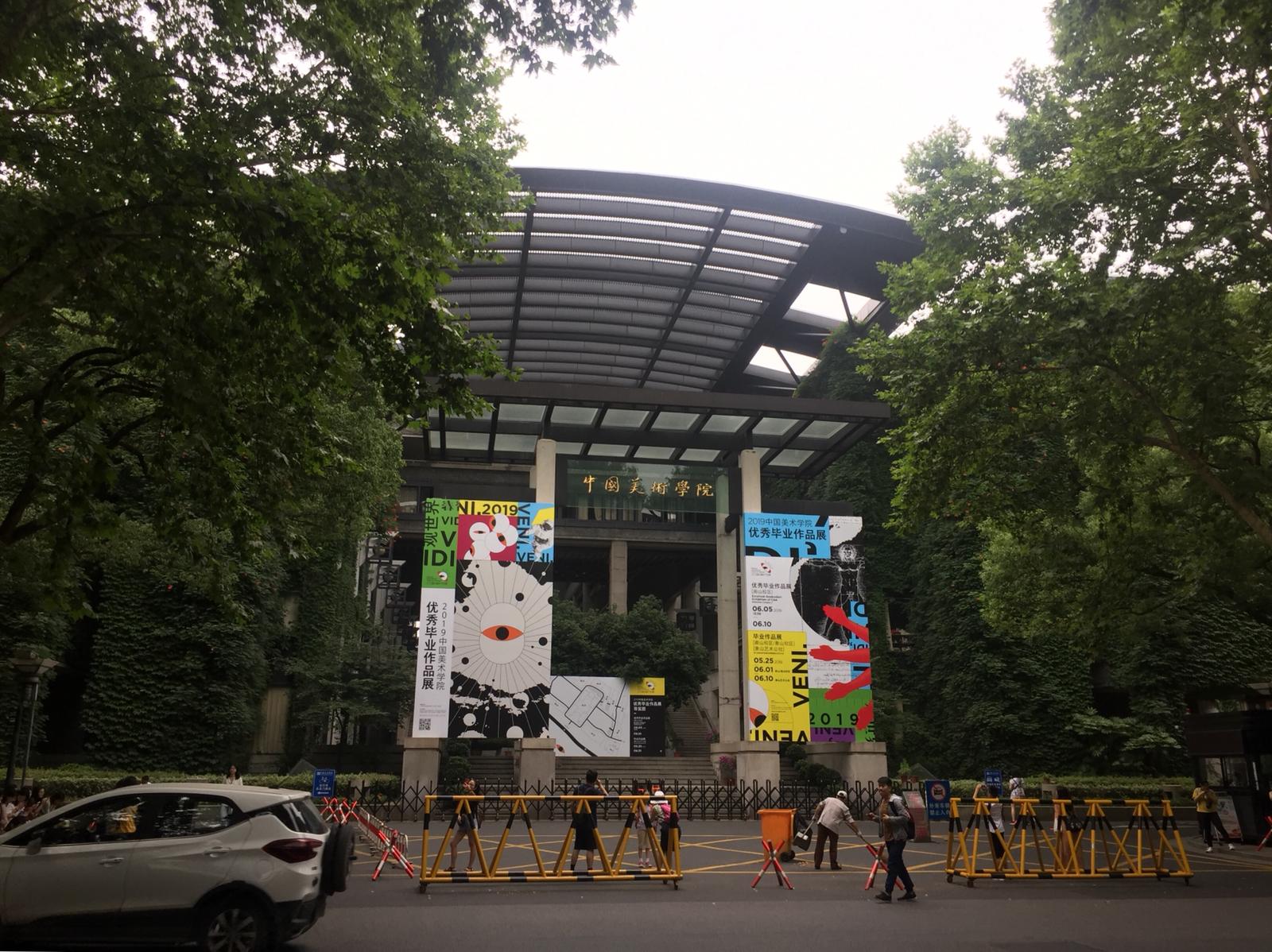 Photo: China Academy of Arts
Photo: China Academy of Arts
Zi Zhu Studio is dedicated to teaching and promoting the traditional woodcut technique called dou ban – the best studio for learning this technique in China. MA art students learn this technique on their three year course at the university, and one of the artists who ArtChina represents in the UK, Wang Chao, is their tutor.
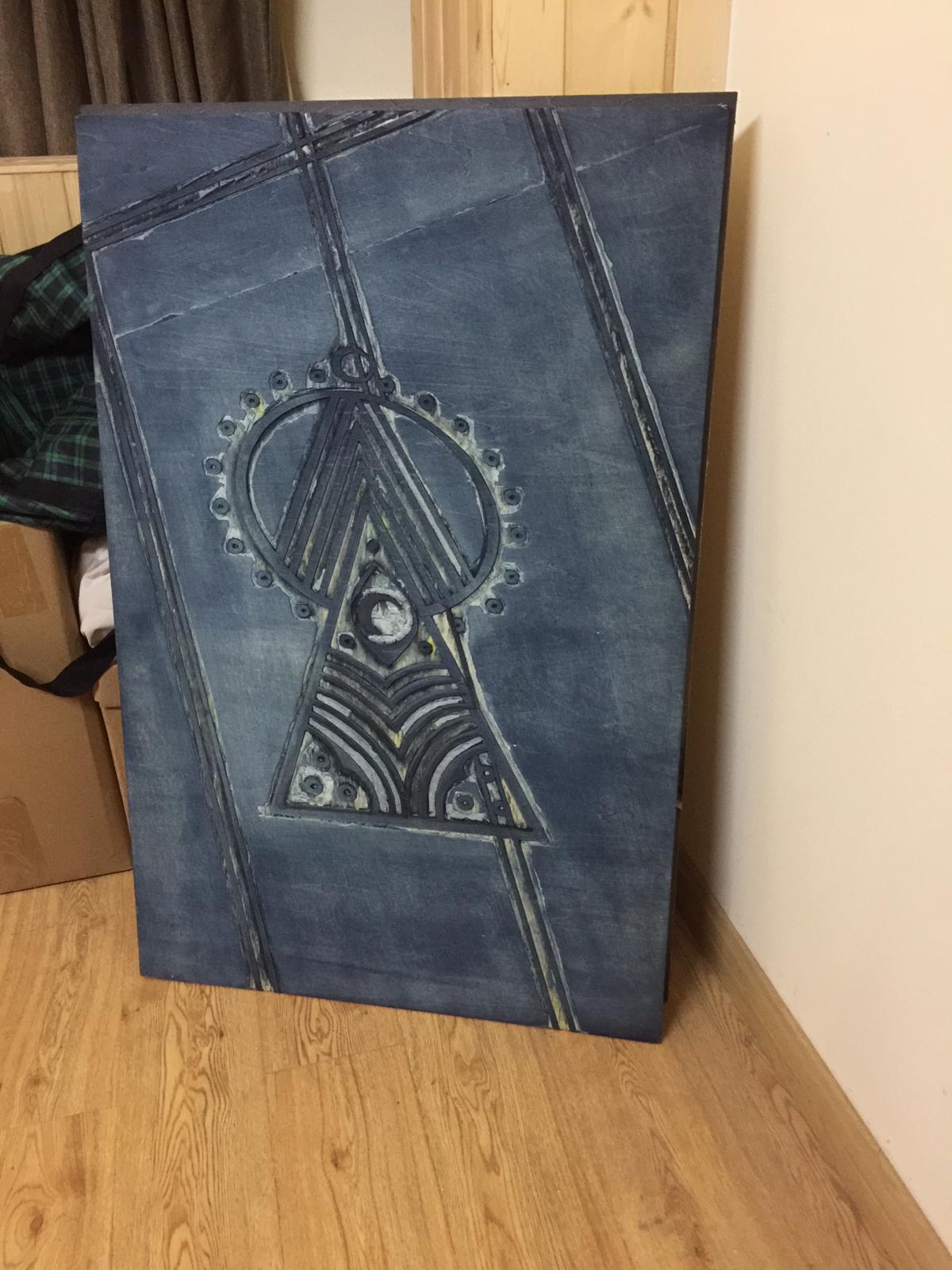
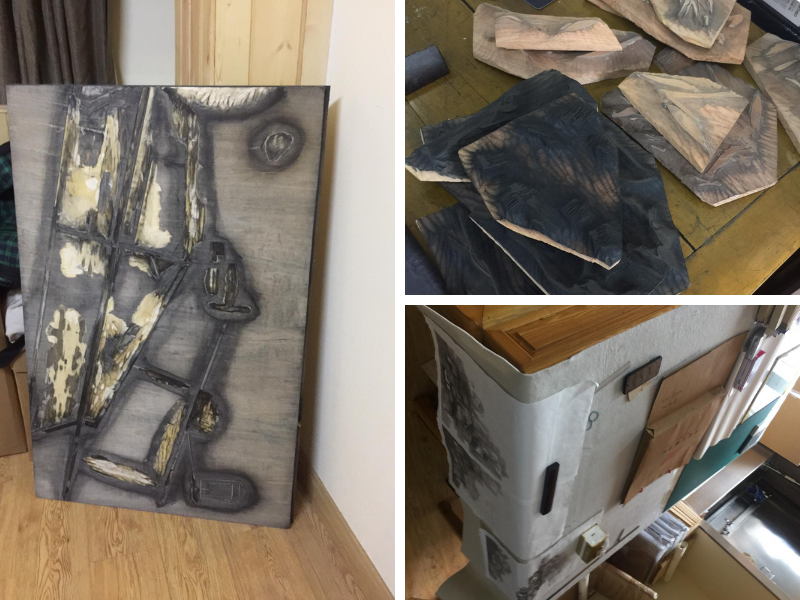
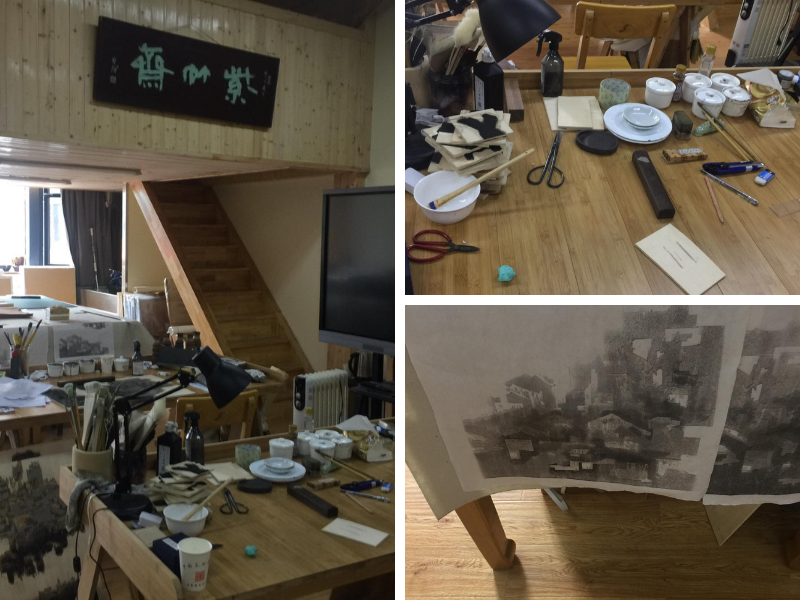 Photos above: Inside of Zi Zhu Studio
Photos above: Inside of Zi Zhu Studio
For two hours, students in the class must practice calligraphy, which is the root to understanding Chinese painting and learning how to control the contour of a line while applying ink to xuan paper. It’s very different from Japan’s water-based woodcut printing table. The printing table here is designed for the purpose of producing multiple prints and, 300 years ago, these used to air dry. In the past, studying woodcut required strong physical ability and was therefore generally taken up by male students, but now the majority of students in the class are female. Zi Zhu Studio encourages students to use this traditional method of creating art to express new, contemporary ideas.
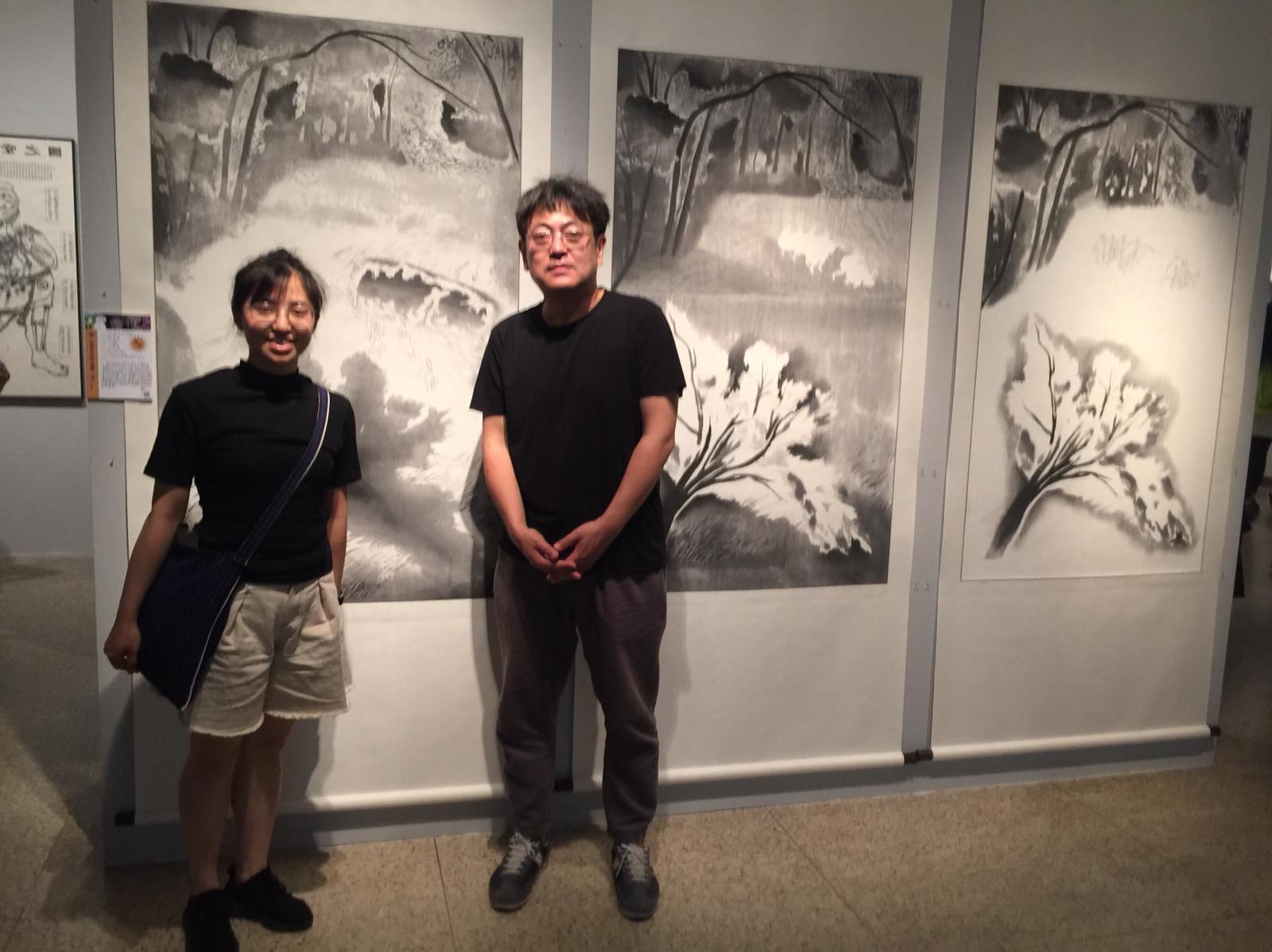 Photo: Wang Chao with a student, in front of her work
Photo: Wang Chao with a student, in front of her work
One of Wang Chao’s students is Cao Ou, who is also represented by ArtChina in the UK, so Aimin was pleased to be able to catch up with both of them on this studio visit.
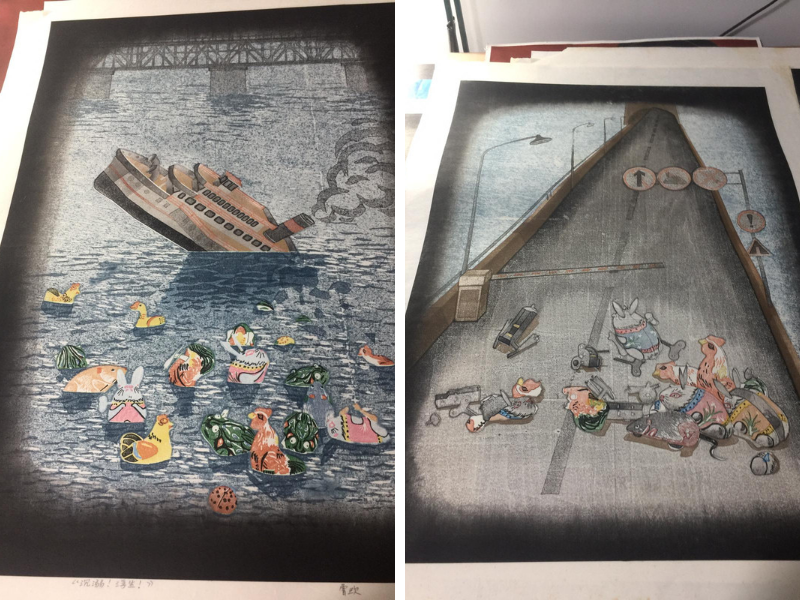 Photos: Cao Ou’s older work, photographed in the studio
Photos: Cao Ou’s older work, photographed in the studio
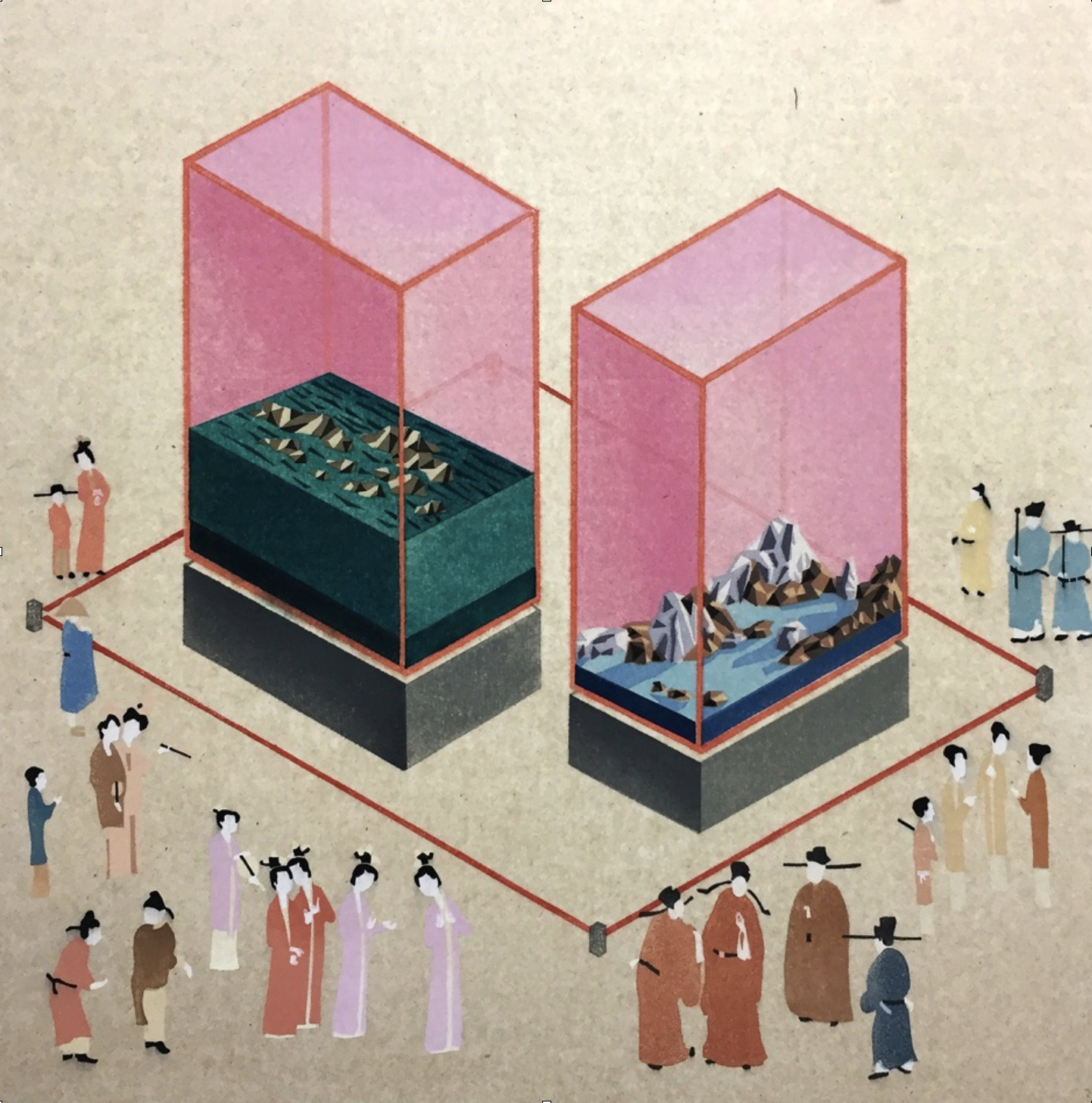 Image: An example of Cau Ou’s current work
Image: An example of Cau Ou’s current work
 Photos: Cao Ou’s studio space
Photos: Cao Ou’s studio space
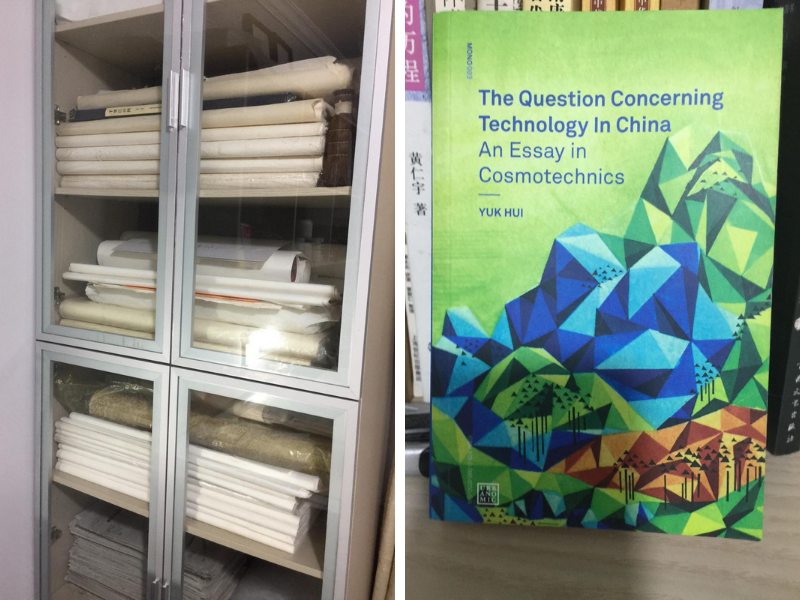 Photos: Cao Ou’s studio storage and his work on the front of a book cover in the US
Photos: Cao Ou’s studio storage and his work on the front of a book cover in the US
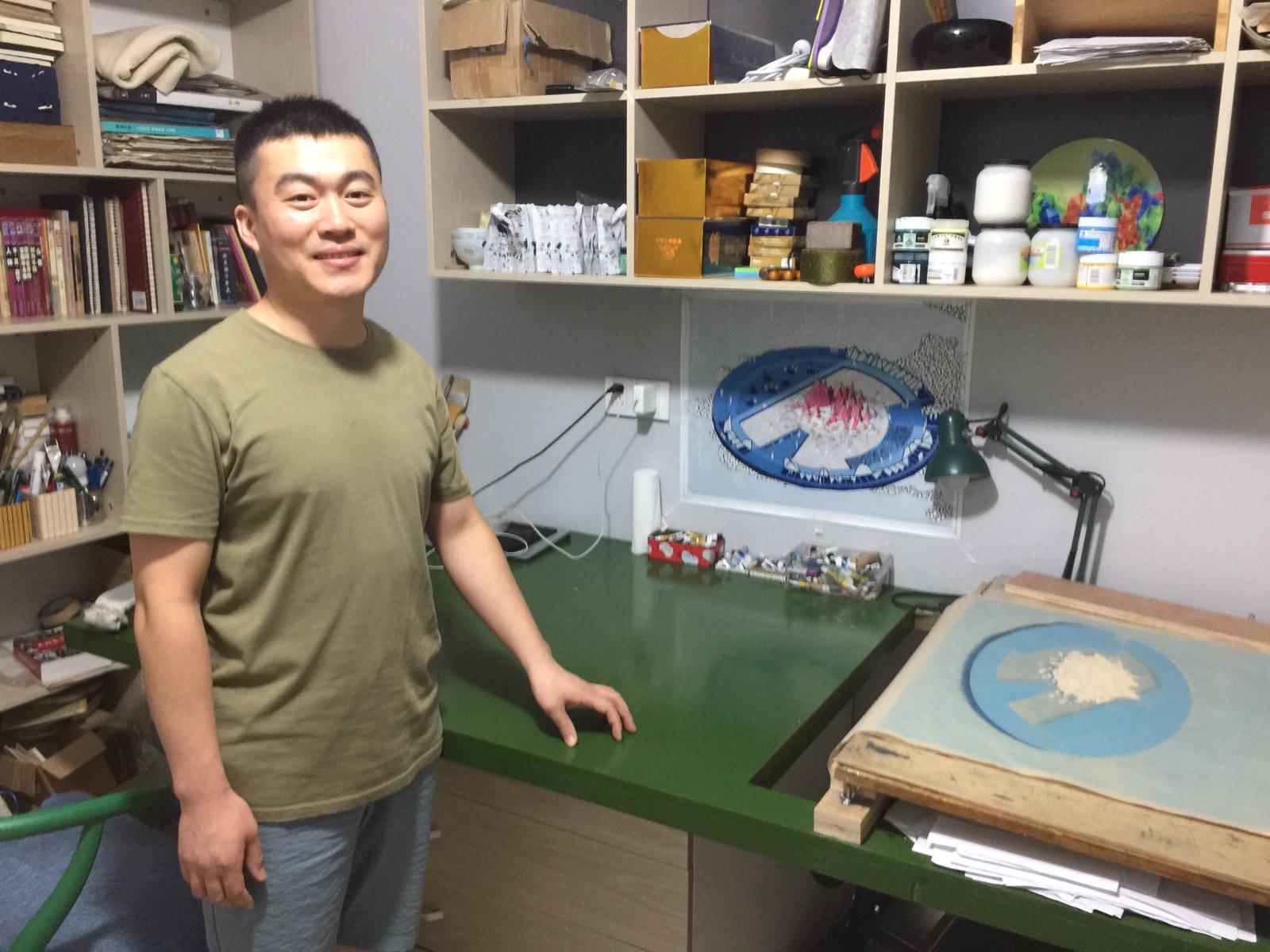 Photo: Cao Ou in his studio
Photo: Cao Ou in his studio
China Academy of Arts is located on the famous West Lake, an UNESCO World Heritage Site, and Aimin was able to spend some time enjoying the serenity of the water and the temples and pagodas that are found in the area. West Lake has long been a source of inspiration for designers, poets and painters throughout Chinese history.
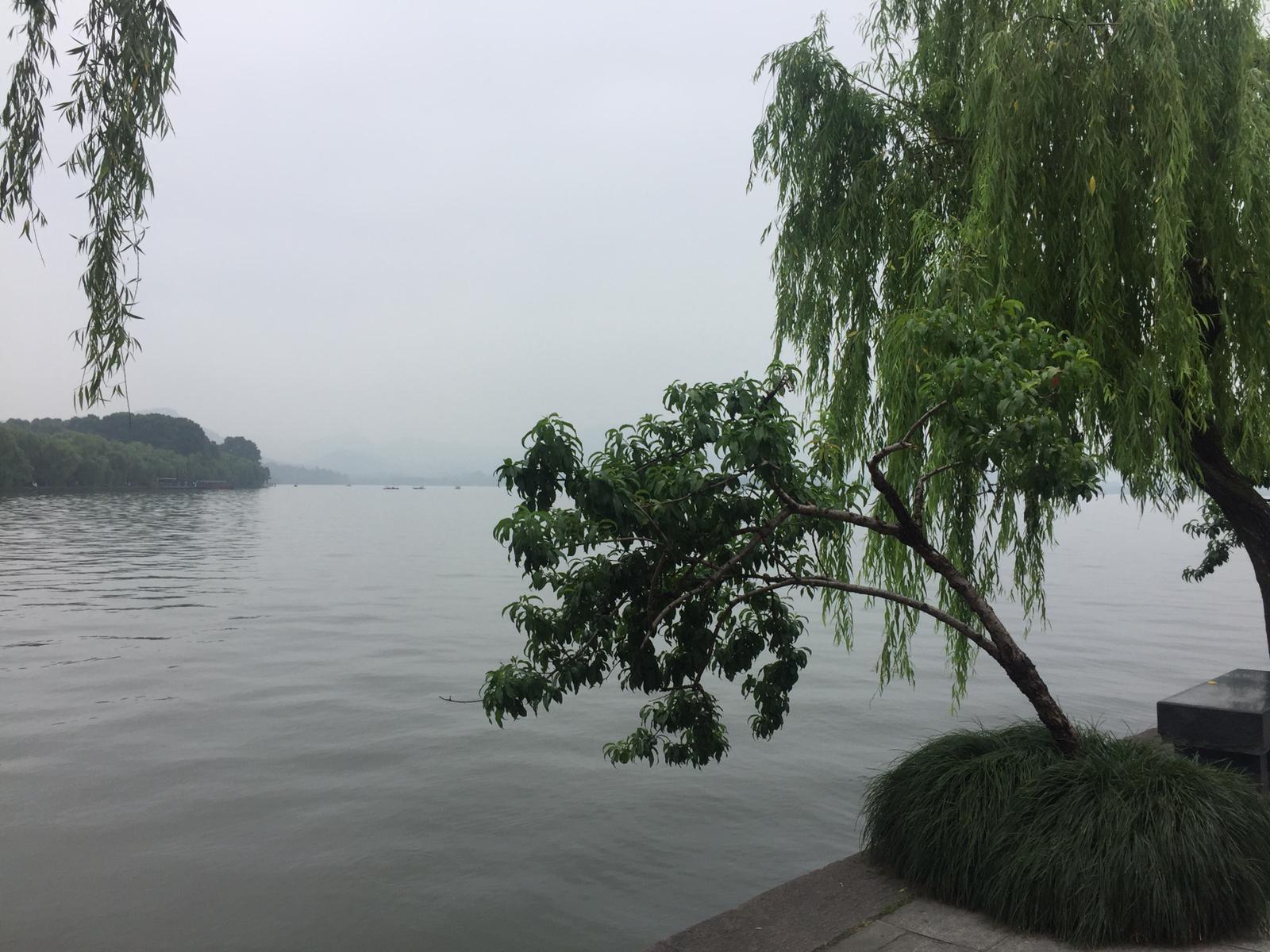

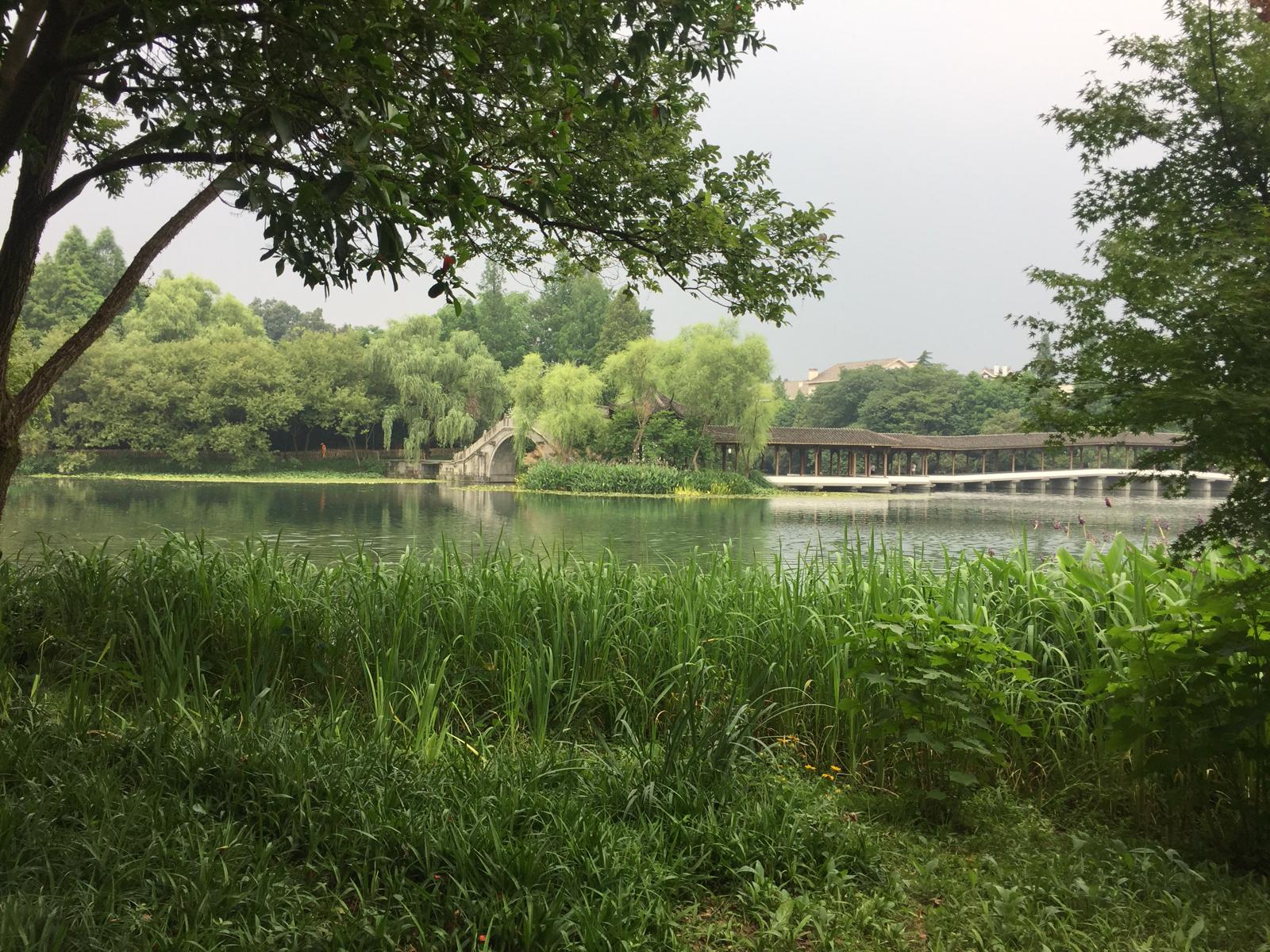
 Photos above: West Lake
Photos above: West Lake
We have woodblock prints for sale from both Wang Chao and Cao Ou.
Please contact us for details.
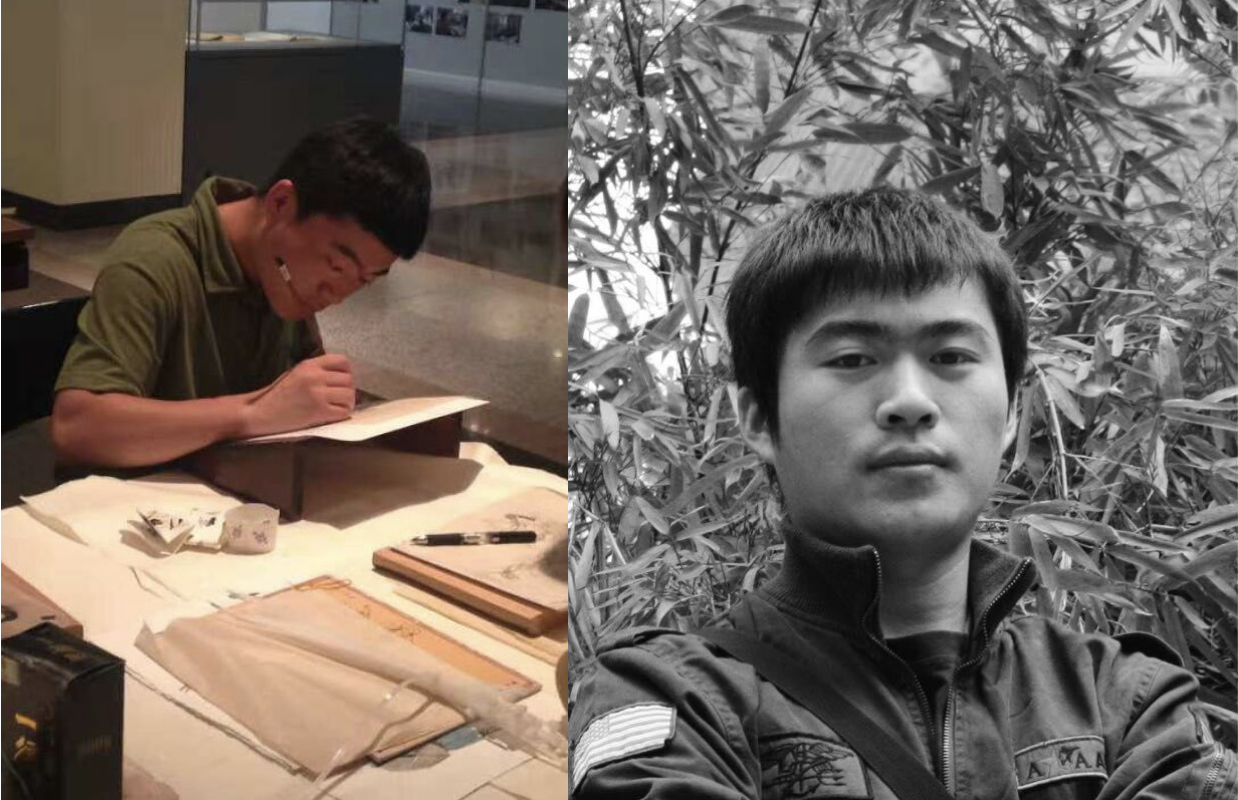
We’re thrilled to be exhibiting the work of Chinese artist Cao Ou at The Affordable Art Fair in Battersea, London next month. We caught up with him to find out more about his work. Read on to find out what he had to say (translated).
On the “Reconstructed Landscape” series:
“Due to the transformation of modern time and space, the modernisation of technology has caused people to lose their natural diversity. However, technology has unified the forms of buildings and roads. When we live in it, we cannot avoid being affected by it. In this case, the concept of landscape should not be placed in a fixed, stylised traditional context. I have been thinking about how to break the traditional aesthetic of people’s habitually.”
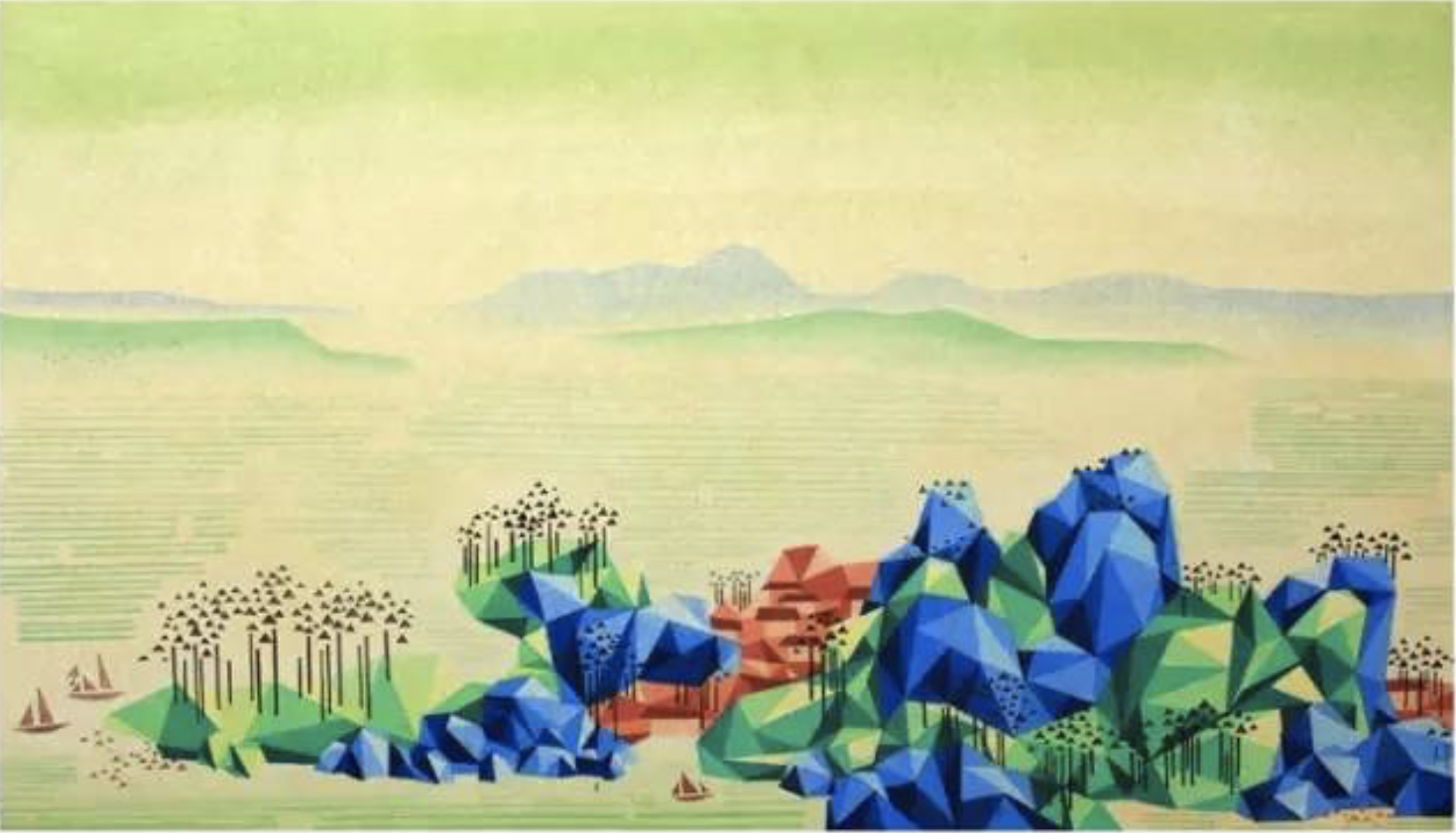 Image: “Reconstructed Landscape-2”, 50×88cm, water-based woodblock, 2014
Image: “Reconstructed Landscape-2”, 50×88cm, water-based woodblock, 2014
“This set of experimental prints is based on the Song Dynasty painter Wang Ximeng’s ‘A Thousand Miles of Rivers and Mountains’, all reinterpreted with a few shapes, which constitutes a visual representation of the landscape, rationally using simple shapes to become a complex composition. The shapes are pilled up into a triangular stacking game. The colours overlap repeatedly, and the use of primary colours creates a dizzy effect.”
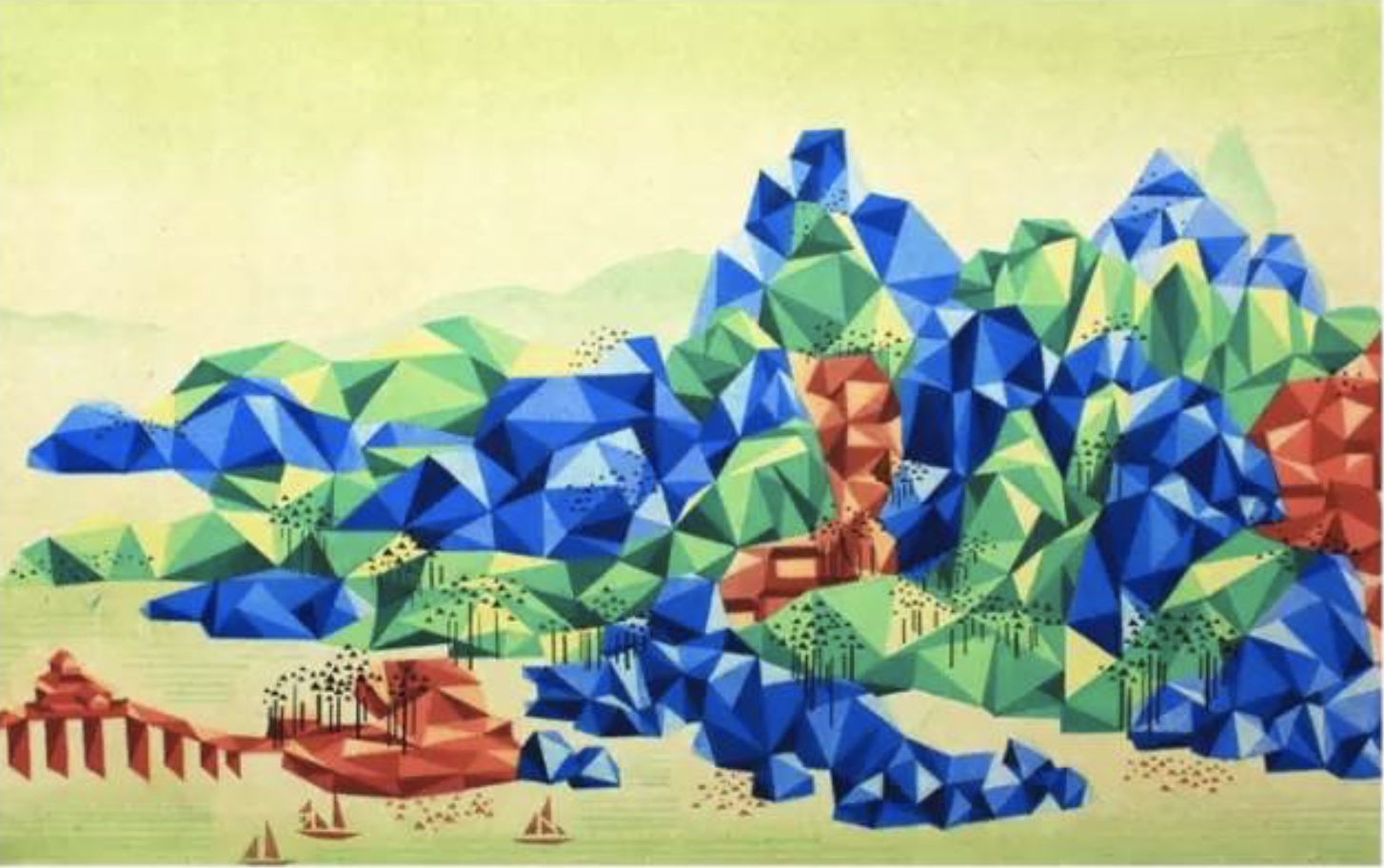 Image: “Reconstructed Landscape-4”, 50×88cm, water-based woodblock, 2014
Image: “Reconstructed Landscape-4”, 50×88cm, water-based woodblock, 2014
“I have always been attracted by the beauty of repetition. I am sensitive to the unified form of mechanised production in life, such as the tall windowsills, the parallel patterns on the walls, and the uniform patterns in clothes. I have always been attracted by these complex and unified forms of beauty, so I chose to use geometry as my linguistic symbol to express the content of the picture in pure form. Sometimes simplification can make the theme of the picture clearer and clearer, more intriguing and more interesting.”
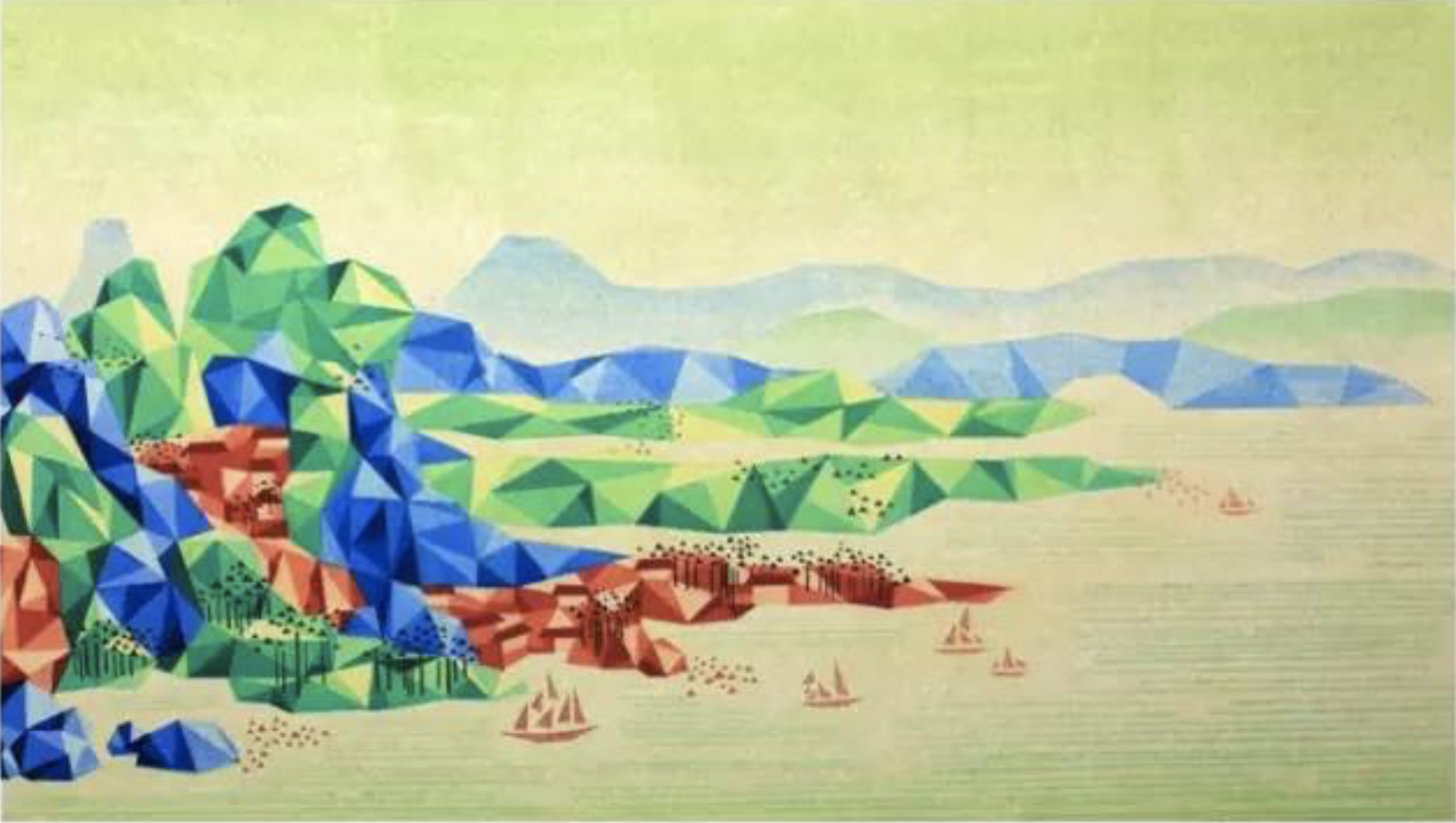 Image: Reconstructed Landscape-3″, 50×88cm, water-based woodblock, 2014
Image: Reconstructed Landscape-3″, 50×88cm, water-based woodblock, 2014
On the “Advanced Animals” series:
“I found my inspiration from the song ‘Advanced Animals’ by Dou Wei (a famous Chinese rock singer). All of my titles are part of the lyrics. The lyrics of “Advanced Animals” show various gestures that reflect people’s lives. One’s life experience decides its character. Due to different psychological characteristics different social circles and working circles are formed. I hope through this series to make the viewers to reflect on their own current environment and find the true colours of themselves.”
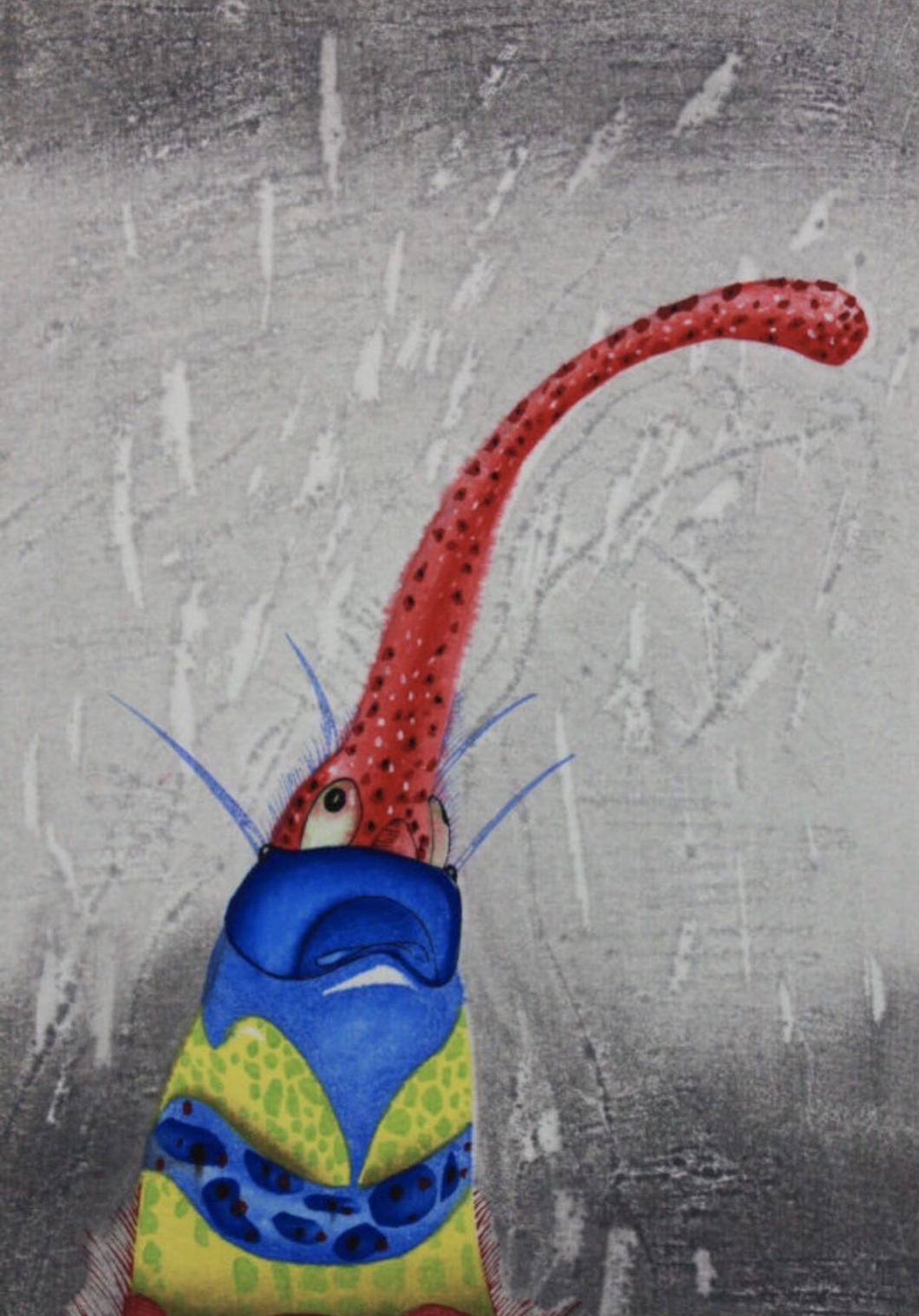 Image: “Advanced Animal”, 20x35cm, water-based woodcut, 2015
Image: “Advanced Animal”, 20x35cm, water-based woodcut, 2015
On the “Theatre Landscape” series:
“This series of works continues and expands on the expression of “Reconstructed Landscapes” with a flat style, using the images to express the multiple relationships between landscape, culture and people or with themselves – tourism, protection, possession, destruction, etc. I hope that the audience will see that this group of works can trigger deeper thoughts on the relationship between humans and our environment.”
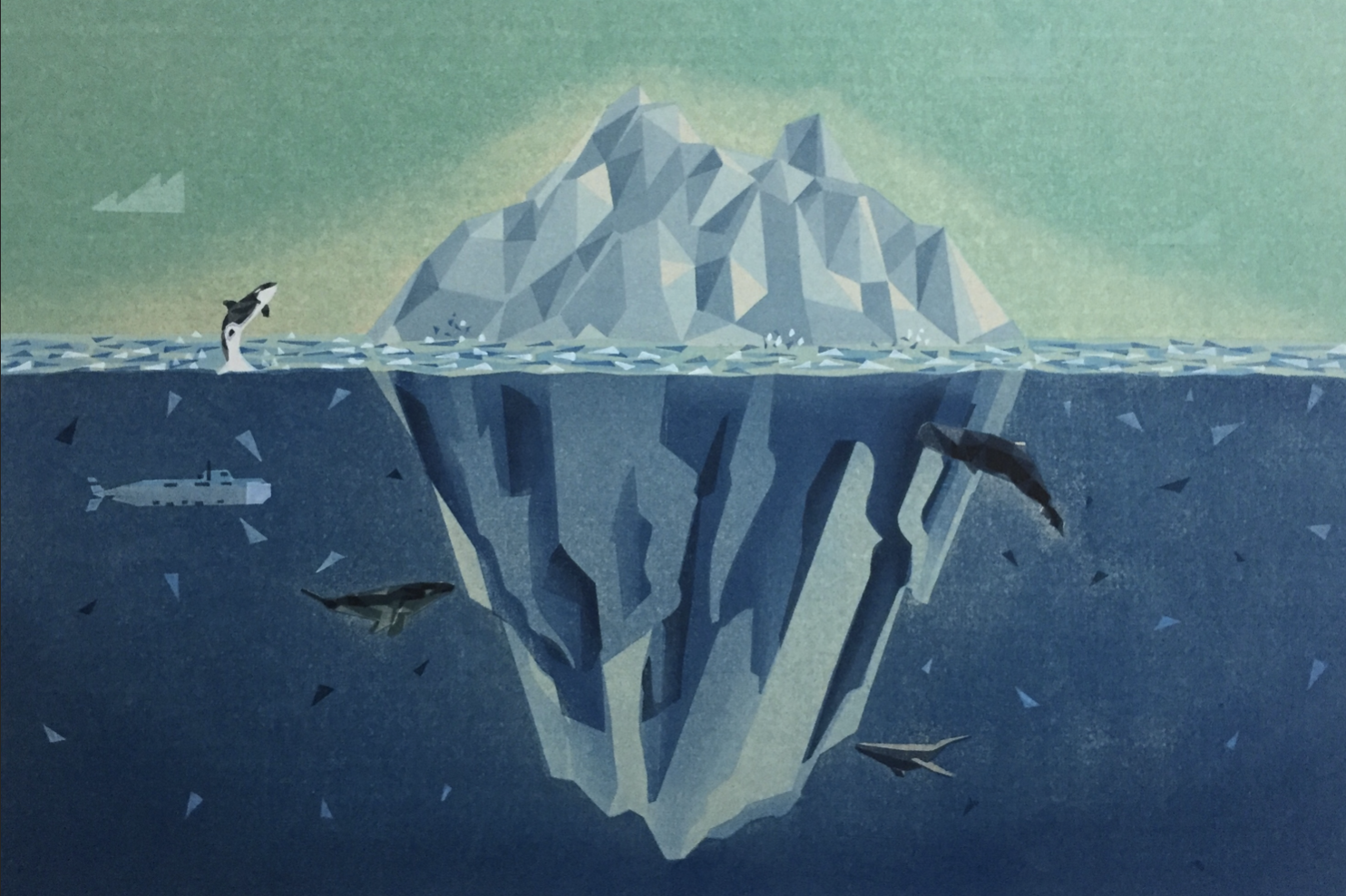 Image: “Theatre Landscape – Floating Mountains & Sea”, 40x60cm, water-based woodcut, 2018
Image: “Theatre Landscape – Floating Mountains & Sea”, 40x60cm, water-based woodcut, 2018
“All my works are printed on Chinese rice paper or Bark paper. The inks are mainly Chinese ink and watercolours, gouache. I use the traditional Chinese water-based printing method called ‘Do Ban’ as the main technique.”
Here’s a short video of Cao Ou at work:
Cao Ou’s cut from ArtChina on Vimeo.
We look forward to presenting his works at the Affordable Art Fair in Battersea from March 7-10. Please use code “ARTCHINAHP” to purchase half-price tickets and come and see us at stand J3!









 My lovely cats
My lovely cats
 Image:
Image:  Image: ‘Theatre’ Landscape – Machine Made, Water-Based Woodcut, 45x60cm, 2019
Image: ‘Theatre’ Landscape – Machine Made, Water-Based Woodcut, 45x60cm, 2019
 Image:
Image:  Image: ‘Theatre’ Landscape – Waterfall Mountain , Water-Based Woodcut, 45x60cm, 2019
Image: ‘Theatre’ Landscape – Waterfall Mountain , Water-Based Woodcut, 45x60cm, 2019 <SURVIVAL! SPACE!>
<SURVIVAL! SPACE!>  <FORWARD? BACKWARD?>
<FORWARD? BACKWARD?> <SINKING! FLOATING!>
<SINKING! FLOATING!>  <LEAP FORWARD! COLLAPSE!>
<LEAP FORWARD! COLLAPSE!>  Photo: China Academy of Arts
Photo: China Academy of Arts

 Photos above: Inside of Zi Zhu Studio
Photos above: Inside of Zi Zhu Studio Photo: Wang Chao with a student, in front of her work
Photo: Wang Chao with a student, in front of her work Photos: Cao Ou’s older work, photographed in the studio
Photos: Cao Ou’s older work, photographed in the studio Image: An example of Cau Ou’s current work
Image: An example of Cau Ou’s current work Photos: Cao Ou’s studio space
Photos: Cao Ou’s studio space Photos: Cao Ou’s studio storage and his work on the front of a book cover in the US
Photos: Cao Ou’s studio storage and his work on the front of a book cover in the US Photo: Cao Ou in his studio
Photo: Cao Ou in his studio


 Photos above: West Lake
Photos above: West Lake
 Image:
Image:  Image:
Image:  Image:
Image:  Image:
Image:  Image: “
Image: “